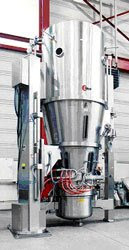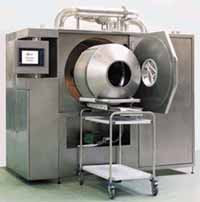The coating of pellets and granules varies from one
Pharmceutical company to the next. Before a pellet
can be coated in a wurster column coater the process
must undergo cGMP. after cGMP is in placed the the
process can proceed smoothly. the product is loaded
in the wurster column with spray nozzle neatly put
in place. The filters are placed securely in the
filter house.The expansion Chamber is placed neatly
and the wurster with product is place in line with
the product bowl. when all parts are in place you
have one vertical chamber.
the equipment is then compressed to create a seal
vertical chamber.
Air-handling system
As the process air enters the fluid bed unit's air-handling system, it can be heated, cooled, humidified, dehumidified, or filtered. A typical layout of an air-conditioning system is illustrated in Figure 9.
Figure 9: A typical layout of an air conditioning system.
Figure 9: A typical layout of an air conditioning system.
Filtration: Following a bird screen, a coarse dust filter is placed where the air enters the system. Additional filtration of the air after heating is achieved by the use of high-efficiency particulate air (HEPA) filters.
Dehumidification: A cooler followed by a droplet catcher dehumidifies the air.
Heating: Process air is usually heated by a finned-tube heat exchanger. The two most widely accepted methods of controlling temperature are modulating steam valves and a face and bypass airflow damper system used in conjunction with a flooded steam coil. The face and bypass system offers the advantages of precise temperature control (+ 1 `C or less) and the ability to change temperatures rapidly during the process with little or no offset.
Humidification: During cold and dry seasons, air humidity may actually be lower than desirable, and rehumidification may be necessary. A clean-steam injector can be used for this purpose after the cold and dry air is heated. Humidification is used primarily to maintain constant inlet conditions and process times.
In many processes, when preheating is required a bypass loop can be used for preconditioned air. This loop allows the required process temperature and humidity to be attained within the vessel before the product is subjected to fluidization.
Heat and mass Transfer
In a fluidized bed, conditions for heat transfer are extremely favorable. A dry, packed bed of particles is generally a good thermal insulator because there is very little contact between adjacent particles; little heat flows by conduction, even when the thermal conductivity of the solid is high. Heat transfer by convection is also small because the motion of the interstitial gas is restricted by the particles. But in a fluidized bed, equilibrium is achieved because the particles at the wall are frequently replaced by particles from the interior of the bed. The high rate of mixing is caused by passing bubbles, which are essential to maintain heat transfer.
In the absence of a temperature probe, product temperature can be inferred. The equilibrium temperature for any surface from which water is evaporating adiabatically (i.e., without heat transfer from its surroundings) is the wet-bulb temperature. As water evaporates in the air, the dry-bulb temperature of the air falls and the humidity increases, but the heat content remains the same. In an adiabatic dryer, the wet-bulb temperature is the true temperature of the solid surface during this constant-rate period.
As in heat transfer, the maximum rate of mass transfer that occurs during drying is proportional to surface area, turbulence of the drying air, the driving force between the solid and the air, and the drying rate. Because the heat of vaporization must be supplied to evaporate the moisture, the driving force for mass transfer is the same driving force required for heat transfer, which is the temperature difference between the air and the solid.
Pressure Drop
To move air in a fluid bed, blowers or exhaust fans mounted outside of the processing area impart motion and pressure to the air using a paddle-wheel action. The moving air acquires a force or pressure component in its direction of motion because of its weight and inertia. This force is called velocity pressure and is me asured in inches or millimeters of water column (wc). In operating duct systems, a second pressure that is independent of air velocity or movement is always present. Known as static pressure, it acts equally in all directions. In exhaust systems (such as fluid beds), a negative static pressure will exist on the inlet side of the fan. Total pressure is the combination of static and velocity pressures.
Blower size is determined by calculating the pressure drops (^P) created by all the components of the completed system. For example, a 28-in. blower creates a pressure differential between the exhaust and inlet blower that is equal to the pressure at the bottom of a 28-in.-high water column.
The blower in a fluid bed system discharges directly into the atmosphere, which is designated as having a pressure of zero (gauge). Therefore, a 28-in. blower creates a ^P of 28 in. between the exhaust and inlet. However, because the exhaust has a pressure of zero, the blower has a negative pressure of 28 in. of water. The ^P created by the fan is dissipated by the equipment located in the system. Table II shows an example of the ^P experienced by various pieces of equipment in a hypothetical situation.
Equipment ^P (in. wc)
Inlet rough filter 0.5
Heater housing 0.5
HEPA filter 2
Inlet plenum & bottom plate 5
Processing material 4
Filter bags 7
Exhaust explosion protective valve 2
Air duct 0.5
Capacity for processing & exhaust air flap 6.5
Total 28
Table II
The exhaust flap dissipates excess ^P not needed to fluidize the material. This flap is controlled by a pneumatic positioner that allows an infinite number of settings. A blower with a suitable ^P will fluidize the process material properly. However, a blower without enough ^P will not allow proper fluidization of the material, resulting in a longer drying time. If the blower develops too much ^P, the control of fluidization will be very difficult. A properly sized blower should develop ^P so that the exhaust flap will be used in the 50 80% open position. When equipment such as scrubbers and duct filters is added, the ^P of the blower can be increased to compensate for the additional resistance created in the system.
Exhaust filter systems
Containing all the product inside the fluid bed system by using an exhaust air filter is one of the most important aspects of fluid bed processing. The ideal filter material should retain all of the product particles in the container while allowing process air to pass through. Cotton, polyester, polypro-pylene, nylon, and expanded polytetrafluoro-ethylene (Gore-Tex, W.L. Gore & Associates, Elkton, Maryland, USA) are the most commonly used materials. These filters can be obtained in 1- to 25-p.m sizes.
The particle size of the product being processed and the type of unit operation (coating, agglomerating, or drying) will dictate the level of porosity of the filter material that should be used. Because the filter can cause a significant ^P, many process failures result from the selection of filter media that have openings of the wrong size.
Process failure can also occur when the filter clogs because of excessive fluidization of fine powder or when filters are improperly cleaned during the process. Too fine a filter will impede fluidization, causing excessive ^P, and a too-coarse filter will cause loss of valuable product carried by process air. Maintaining a large filter area ensures proper airflow and reduces ^P due to impingement from overfluidization. Reduced-area or pleated filter media can be problematic, because the ^P across the filter bag can increase with air speed.
Process considerations
Airflow in drying: One constraint in using a fluid bed dryer is the inability to achieve uniform fluidization. An indication of good fluidization is a free downward flow of the granulation at the sight glass of the drying bowl, but such limited observation could be misleading. It is possible to detect this situation by monitoring the outlet-air temperature. Every product has a unique constant rate of drying period in which the bed temperature remains relatively constant for a significant length of time. Therefore, if the outlet-air temperature rises more rapidly than anticipated, it is an indication that fluidization is incomplete. In this case, the process must be stopped, the granulation stirred to distribute the moist material, and the process restarted.
Airflow in granulation: While the granulating solution is being sprayed, the exhaust flap is controlled to achieve proper fluidization. The objective of this process is to fluidize the powder for maximum exposure to the spray nozzle. Whereas overfluidization may produce uneven or lumpy agglomerates and may also cause filter plugging, underfluidization may stall the bed and ultimately lead to bed collapse. Filters can also become plugged.
Minimum fluidization velocity depends on particle size' and particle humidity.4 As both change during the granulation process, it is necessary to vary the air velocity to maintain uniform fluidization. As the product dries, its density changes and less airflow is required.
The difference between the temperatures of the drying air and the product surface is expressed as ^T. It is necessary to distinguish between ^T in the granulation phase (^T"") and ^T in the drying phase. Gran- ule size is directly proportional to the moisture content of the bed in the granulation phase. ^ gran primarily affects granule growth. As the value of ^T is increased, drying time is decreased. Variations in inlet-air humidity thus affect the granule size by either increasing or decreasing ^Tgranas the drying capacity of the air changes. This influence can be eliminated by keeping the difference (^T) between the inlet-air temperature and the wet-bulb temperature constant.
Airflow in coating: Tablet, pellet, and particle coating are all performed in fluid bed equipment using a top spray, a bottom spray with a Wurster column, or a rotary coater. The coating process involves the deposition of droplets on the substrate material, followed by spreading and coalescing of the droplets, which form a continuous layer as they adhere to the matrix. Throughout the process, solvent is evaporating. It would be impossible to dry any more solvent than the drying air can accept or to dry any faster than the solvent can be heated to its vapor-transi-tion temperature. In a system with good product turnover and proper exposure to spray, the one remaining requirement for successful coating is the drying system. If water is present in the organic solvent solution and dew points are not controlled, then the drying capacity varies, and the driving force for the evaporation of water is affected. It is advisable to control ambient air dew points in organic solvent processes and in aqueous coating operation.
Conclusion
The fluidized-bed unit is one of the most versatile pieces of Pharmaceutical
and food processing system.
Sunday, June 7, 2009
Subscribe to:
Posts (Atom)



